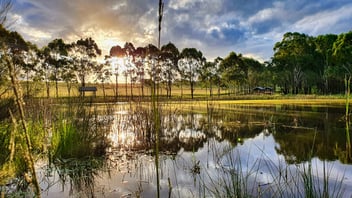Collaboration to Improve Regional Water Supplies

Paul Reiter was the Executive Director of the International Water Association from 2002 to 2012. He then transitioned into a role as Strategic Counsel and was later appointed Distinguished Fellow of the IWA. He is now the President and CEO of consulting company Reiter International Water Solutions Ltd and consults on regional and international projects, focusing on end-use consumption, resources planning, metering technology and tariff studies.
Danny Burkett, Chair of the Regional, Rural and Remote Specialist Network, spoke with Paul about his experience and learnings in helping regional water suppliers collaborate to achieve improved outcomes for their communities.
1. Can you tell us a little bit about your engagement with regional, rural and remote (RRR) water infrastructure? How your engagement with this topic started?
An economist by training, I worked for over 20 years with local and regional water authorities in the USA which included serving as the Utility Coordinator for the City of Seattle before becoming Deputy Director for Strategic Policy at Seattle Public Utilities. In 1999, the International Water Association (IWA) was formed and in 2002, I served as the IWA Executive Director for 10 years and played an integral role in ensuring the successful integration of communities in the newly merged International Water Association. I helped establish IWA as a leader in the international water sector and oversaw the expansion into a Global Operations Office in The Hague and Regional Offices in Singapore, Beijing and Nairobi.
It was through my involvement with IWA in developing countries including Africa, Central and East Asia and South and North America that it was clear that there were significant differences in the abilities, capabilities, resources, planning and operation of water utilities.
This includes utilities that may appear to be effective but were inefficient in providing a vital service even if they were a public or a private organisation. The efficiency of the water utility is not limited to supplying services to their customers but also protecting the environment, managing fire flows, impacts on natural stormwater quantities and qualities and suitable technology and systems for that specific utility.
In a regional context, where the population is less than 2000 people, there are also differences between the needs and abilities of urban versus rural communities as they will each have their own opportunities and challenges with regards to governance, natural resources, suitably trained employees, availability of critical chemicals and appropriate technology. In general, the large cities and utilities have set the water quality standards and there is a reasonable expectation that these should also be adopted in non-metropolitan areas. However, adopting the same high-level technology into a regional area doesn’t easily allow access to the right personnel to keep the systems operating as they should be.
2. Whilst the ideal situation is to have the right technology and suitable personnel to successfully operate a water system, what do you consider should be prioritized?
For the water supply system, there are two questions that should be asked. The first is to do with the standard that is required. Should it be good, better or best? A reasonable fit could be somewhere between good and better and if the available resources have the skills to operate and maintain this type of system, then there is likely to be a good match. Prioritizing one over the other will eventually lead to unacceptable outcomes. For the standard from large scale technologies to become the standard for small scale projects, this is in my opinion, fatal. An example of this is a groundwater pump. What would happen if the pump stopped working? Is there someone in the community who can fix it? If it has minimal components, the likelihood of it being repaired is significantly increased.
Another aspect that could be considered is whether to build one big wastewater treatment plant or build 10 small scale systems? If the small-scale systems can collectively achieve 90% of the outcomes of the one large plant, but the ten systems can work every single day, it is suggested that the latter is implemented.
3. Where have you seen very good collaboration between regional water utilities and what did they do to achieve that collaboration?
For effective collaboration, there needs to be an overarching organisation, or organisations, that have the ability to link, either physically or virtually, smaller utilities together.
In the majority of Australia, this has occurred by the establishment of State government water utilities and it is similar in France, for example, where large private organisations are responsible for several thousands of small water supply utilities. These overarching organisations provide opportunities to establish critical ‘centers of expertise’ that can provide specific governance across numerous locations. This principle was one of the objectives of establishing the IWA as it could provide guidance and opportunities for the small, isolated water utilities to link with larger utilities.
In situations where there are numerous independently managed water utilities, organisations such as the Australian Water Association (AWA) and Water Services Association of Australia (WSAA) play a significant role. Other knowledge sharing comes from design consultants, equipment suppliers and universities who share knowledge nationally and internationally. These collectively create the overarching organisations where the transfer of knowledge, support for operations and maintenance and the introduction of appropriate technology can occur. The relationships between remote utilities could simply enable knowledge sharing and don’t necessarily require the need to have commercial arrangements in place. To learn from each other is a key element rather than trying to completely work something out on your own. An example of this occurred in Europe after World War 2 when western European countries collaborated to develop industry standards and codes.
4. What makes for a sustainable water project in regional, rural and remote areas?
The provision of a sustainable project requires a concentrated and proactive effort from all parts of an organisation who all have a shared commitment and responsibility for the short- and long-term viability of the project and the larger system as a whole. This includes planning, financial management, staff training and openly learning from the broader water community for aspects such as asset management and improved operational practices.
The other aspect for sustainability is the scale of the project. If the water utility is too small to have suitable expertise for the project, it is unlikely to be sustainable. During the procurement process for a new asset, the utility needs to be very clear to communicate their capabilities to the designer or supplier as this can reduce the risk of the utility not being able to operate and/or maintain the asset without ongoing external support.
5. Can you describe what makes for meaningful community engagement?
As I mentioned earlier, I worked for the City of Seattle. Back in the 1850’s, there was a bid to build a municipal water system, but it was rejected twice. A few years later, the City had a massive fire and significant areas of the City were burnt to the ground. A third ballot to build the water system was presented and there was a 90% approval rate. The system was built with reservoirs in the mountains and long pipelines to the city. About 70 years later, the system was showing signs of significant maintenance which would require hundreds of millions of dollars in funding. Up until then, the community had paid relatively low rates. For the system to be updated, it would require substantial increases in the rates. The City had to build up the trust from the community.
To do this, the community needed to be told what the problem was and what was needed for it to be addressed. In this context, the community were both customers and owners of the water supply system. This was the bridge that enabled trust to be developed as the community demanded service quality, but they also needed value for money. This was an example of maintenance and funding of the system becoming lumpy – that is, there were step changes in costs which varied from year to year.
The maintenance of a small system needs to focus on a whole of life cycle basis with relatively consistent maintenance and capital budgets year after year. This requires sustained leadership from the water utility rather than limiting it to political cycles.

